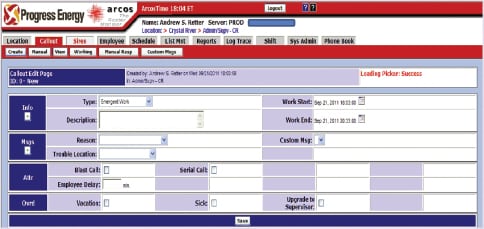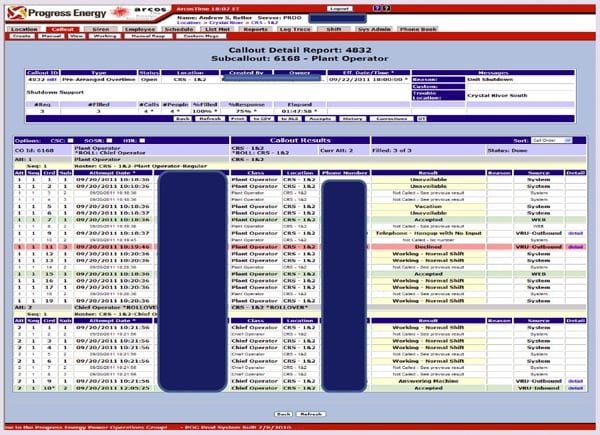Automating Crew Callouts
Progress Energy has adopted an emergency worker callout program that has eliminated manual dialing, improved work acceptance rates, and increased the speed of worker reporting. The standardized process also complies with union work rules that require equality in overtime opportunities, by seniority. The business case for automating the worker callout process is compelling.
The Crystal River Energy Complex, owned by Progress Energy Inc., is located on a 4,700-acre site north of Crystal River in Citrus County, Florida. On that site are five units situated in three distinct areas (Figure 1). Crystal River 3 is an 860-MW nuclear facility that began operation in 1977. The North Plant (center right in Figure 1) consists of the identical coal-fired Crystal River Units 4 and 5, each rated at 717 MW. These two units entered commercial service in December 1982 and October 1984, respectively. The older South Plant (top of Figure 1) comprises the 373-MW Crystal River Unit 1, which began operation in October 1966, and the 469-MW Crystal River Unit 2, which entered service in November 1969. With a combined capacity of nominally 3,150 MW net, the complex is among the top 10 largest electricity-generating facilities in the U.S.
 |
| 1. Top 10 plant. Progress Energy’s Crystal River Energy Complex consists of a nuclear plant and the fossil-fired North and South Plants. The combined output of the complex is about 3,150 MW. The complex is one of the 10 largest power-generating facilities in the U.S. Courtesy: Progress Energy |
Fossil operations, the focus of this article, include the North and South Plants and two coal yards with six miles of conveyors. Each plant and the coal facility has an assigned operations and maintenance organization managed by a reporting headquarters. Shift supervisors, Progress Energy employees, have the primary responsibility for day-to-day plant operations. The remainder of the fossil staff consists of 350 bargaining unit employees. The maintenance organization is staffed 24/6 in 8-hour shifts; operations run 24/7 with 12-hour shifts.
Filling the Gaps
One of the less-desirable responsibilities of a shift supervisor used to be tracking down replacement operators or maintenance craft employees when someone called in sick, when there was emergent work (such as a forced outage with a need for immediate repairs), or for routine shift replacements, such as vacation fills. In past years, a callout for the first two categories of callouts required a shift supervisor to make dozens of phone calls and then wait for returned calls (if the calls were returned at all). Depending on the number and type of skills required, this process routinely took four to six hours of a supervisor’s time, which was better spent monitoring operations.
Further complicating the callout process was the inconsistency across the site’s different fossil organizations and the fact that there were seven different groups performing callouts, sometimes twice a day. Also, if the callouts occurred when a maintenance foreman was not on site, then the operations shift supervisor was tasked with that callout. In other words, managing callouts across such a complex site was complicated.
The bargaining unit contract requirement that overtime was to be “fairly distributed” also introduced a number of challenges. Inconsistencies with callout prioritization and with how the contract was interpreted resulted in numerous bargaining unit grievances, which consumed more shift supervisor and valuable plant and union management time. A better callout process was needed to increase efficiency and satisfy all of the stakeholders.
Making the Business Case
A few years ago, fossil operations began developing a business case for investing in callout automation software. The first step was to understand the automated callout experience of the energy delivery side of the business. The energy delivery organization, well experienced with callouts—particularly during storm season—had already implemented ARCOS Inc.’s automated crew callout and scheduling system with great success, and use of the software was now firmly embedded within that organization’s work practices. In fact, the energy delivery organization reported that, although there was some resistance at introduction, the organization today would get a bargaining unit grievance if it were not using the software, although the company maintains the right to perform manual callouts should the need arise.
An expected benefit of the investment in the ARCOS software was consistent compliance with the bargaining unit contract requirements for equal distribution of overtime. Having a historical record of callouts would make it simple to demonstrate the company’s compliance with those contract requirements. Shift supervisors also supported the new automated process because it meant they were spending less time “dialing for dollars” and more time supervising plant operations.
Making the business case to upper management became easier when the effects of labor reporting times on replacement power costs during forced outages was included in the evaluation. The time supervisors spent on manual callouts also had a significant financial impact.
Automating Callouts
The ARCOS web-based automated callout solution, selected by plant management for the two Crystal River Energy Complex fossil plants, was launched on August 30, 2011. Implementation of the program began a few weeks earlier with about one hour of user instruction and assignment of PIN numbers to the 350 bargaining unit employees. In addition, badge cards, refrigerator magnets, and a Q&A sheet provided instruction on how to use the system. Later, a Sharepoint site accessible to all supervisors was added containing FAQs, training materials, and user manuals. Supervisors were provided eight hours of training to learn how to manage the employee lists, implement callouts, and perform other software management functions. Managers at the complex attended a two-hour overview of ARCOS.
One feature of ARCOS was of particular interest to shift supervisors: web access. The web-based software allows a supervisor to initiate a callout from any location, even from home (Figure 2). Since the first software release, a number of improved work practices have been implemented that benefit employees.
 |
| 2. Launch a callout. A single form is used by a shift supervisor to initiate a callout. Courtesy: Progress Energy |
Transparency in Operation. The callout priority list configuration developed by ARCOS is designed to comply with overtime order requirements and other callout equal distribution rules in accordance with the collective bargaining agreement. When a callout is required, the supervisor specifies the skill requirements, and then ARCOS generates the priority lists and makes the calls according to the agreement (Figure 3).
 |
| 3. Callout history. One of the desirable features of the ARCOS software is that a complete history of each callout is kept online so that a shift supervisor or a union representative can audit callouts to ensure work rule compliance. Courtesy: Progress Energy |
Follows Work Rules. If an employee tells ARCOS he is unavailable during a particular period, the system will not include that employee on the callout list during that time. For example, employees can remotely set their availability to unavailable for callout if they are out of town during days off or may tell the system they have a personal commitment affecting their availability. However, employees who intentionally pass an assignment will be redlined or charged for any potential overtime they may have been called out for, according to the collective bargaining agreement. ARCOS also knows not to send a callout to an employee who just completed a callout. The time between callouts is user-defined.
User-Friendly Interface. Users can respond to callouts using individual PIN numbers and a pushbutton phone, much as they would when refilling a pharmacy prescription. The software confirms selection keystrokes to eliminate selection errors.
Tangible Results
Since the software solution went live last August, the shift supervisor time to initiate a callout has dropped from up to six hours to less than 30 minutes. Just as importantly, since the system went live, there have been no bargaining unit grievances contesting the fairness of overtime assignments.
The entire ARCOS system upgrade paid for itself in eight months with the reduction in shift supervisor labor alone. Today, supervisors have more time to focus their expertise on recovering from a forced outage, inspecting systems, or mentoring operators rather than worrying about employee callouts.
— Scott Retter ([email protected]) is a continuous business excellence lean leader with the Power Operations Group at the Progress Energy Crystal River Energy Complex and has 25 years of plant operating experience.